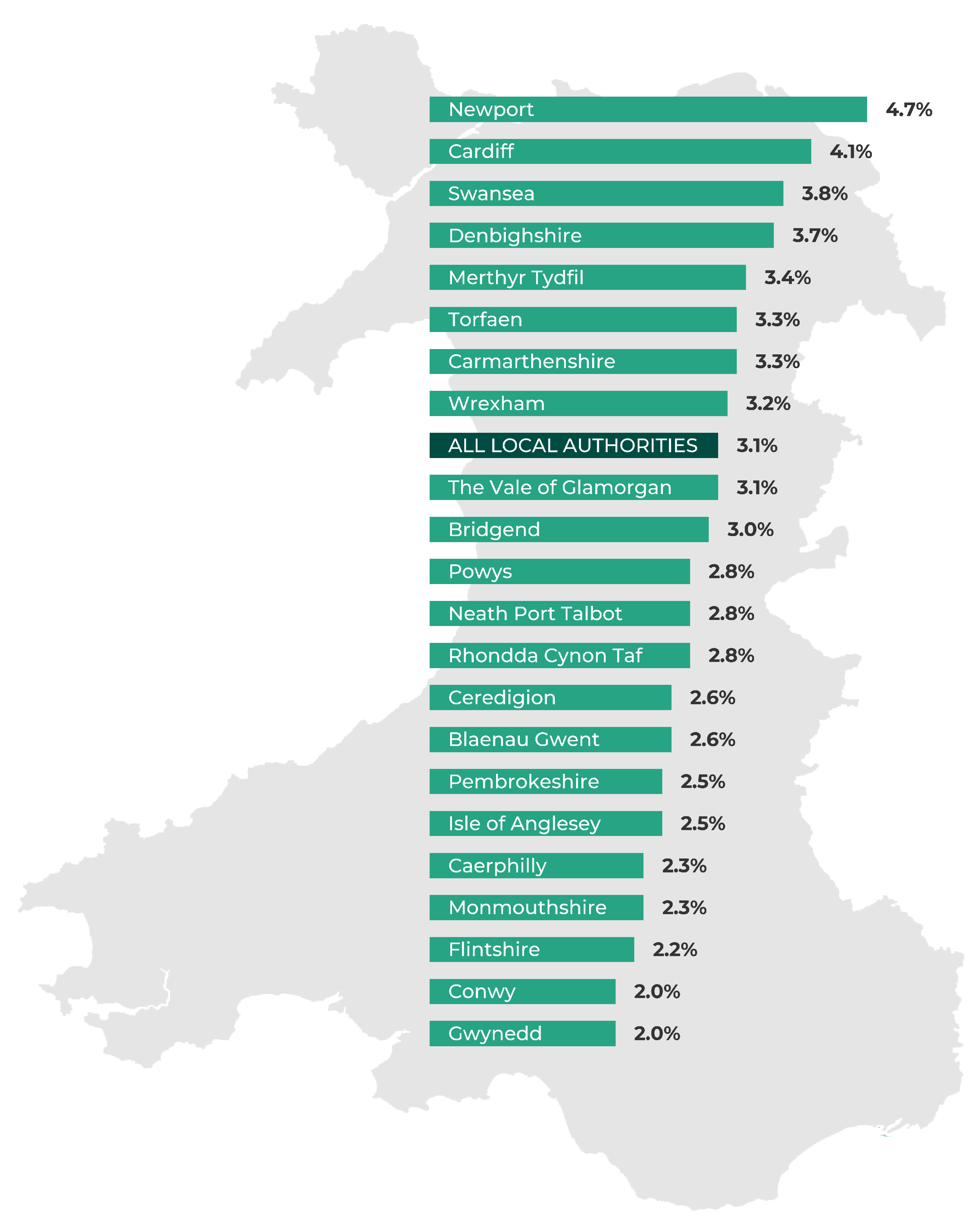On 20 December, the Welsh Government set out details of its funding for Wales’ 22 local authorities in its Draft Budget for 2024-25.
In this article we look at this Provisional Local Government Settlement, the pressures facing local authorities and what this means their budgets next year. We also look at police funding for 2024-25.
Core funding across local authorities will increase by 3.1%
Overall core revenue funding (known as Aggregate External Finance or ‘AEF’) for the 22 local authorities is provisionally set to rise by 3.1%. For context, the overall increase for 2023-24 was 7.9 %. The allocations to local authorities are derived using a formula agreed with local government.
The largest percentage increase for 2024-25 is for Newport (4.7%) and the lowest for Gwynedd and Conwy (both set to rise by 2%).
The Minister for Finance and Local Government confirmed that additional funding of £1.3m was being provided to ensure no authority would receive less than a 2% increase.
Figure 1: Provisional change in AEF by local authority (2023-24 to 2024-25)

Other funding available to local authorities
The Welsh Government says it will also provide £1.3bn for revenue and over £960m for capital grants in addition to the core funding for 2024-25.
Core capital funding is maintained at £180m, the Minister for Finance and Local Government said this is due to “next to no increase in overall capital funding and the Welsh Government capital budget being 6% lower in real terms than the current year”.
Local authorities are also in the process of setting their own budgets for the upcoming financial year. This includes setting council tax levels, which are reported may be set to rise.
Whilst the 3.1% settlement was welcomed, councils are concerned that “it’s not meeting the cost pressures that local authorities are finding” and protecting front-line services is “becoming impossible”.
In their response to the Finance Committee consultation on the Welsh Government’s 2024-25 Draft Budget, the WLGA estimated local authorities faced a potential cumulative funding gap of £1.294bn by 2026-27.
The Leader of Wrexham County Borough Council said £800m in extra funding is needed across Wales’ 22 local authorities for them to be sustainable, not the £170m which the 3.1% settlement equates to. He went on to say:
[…] I’ve never know a time like it. It’s tragic, and if you add up all the redundancies and job losses across Wales, for all of us, across the 22, it will be in its thousands.
The leader of the Isle of Anglesey County Council highlighted potential reductions in services:
Even though there has been an increase, it's important to note that the increase can't protect services, and we're all looking at cuts to those services.
Concerns regarding funding also extend to social services. The Association of Directors of Social Services Cymru (ADSS) highlighted the issue of overspend in social services, and Bridgend County Borough Council highlighted pressures of £260m for social care alone.
The Final Police Settlement
The Welsh Government also published its part of the Final Police Settlement for Wales 2024-25, in a process similar to that for local authorities. Policing policy isn’t devolved and this funding is delivered through a three-way arrangement that means some funding comes via the Welsh Government, some through the UK Home Office and some via council tax.
Next year, the police forces will receive overall core funding of £459.8m, an increase of 2.1% compared to 2023-24. Of the £459.8m, the Welsh Government’s provisional contribution will be £113.47m.The figures remain as those set out in the Provisional Police Settlement announced on 14 December 2023.
The police settlement is also not immune to inflationary pressures. In announcing the provisional police settlement), the Minister for Finance and Local Government said:
I recognise that against the background of recent high rates of inflation this will require the four police forces in Wales to make difficult decisions on services, efficiencies, and council tax precepts.
In addition to UK and Welsh Government funding, Police and Crime Commissioners (PCCs) are responsible for setting a budget and deciding what further funds need to be raised from the additional charge on council tax, this is called the police precept.. For 2024-25, increases in that precept range from 4.97% (North Wales) to 7.7% (Gwent). The South Wales precept increase is yet to be confirmed. As with local authorities, Police and Crime Commissioners are in the process of setting their budgets for the forthcoming financial year.
Where can I keep up to date on the settlements?
The Senedd is due to debate the Draft Budget tomorrow (6 February). The Final Budget is due to be published on 27 February, and debated on 5 March. In the meantime, the Senedd will debate the Final Police Settlement on 20 February. You can watch all debates live on SeneddTV.
The Final Local Government Settlement is likely to be published and debated along the same timescales as the Welsh Government Final Budget.
Article by Božo Lugonja and Ahmed Ahmed, Senedd Research, Welsh Parliament






